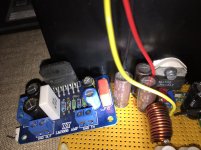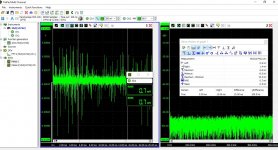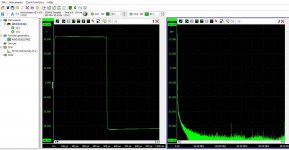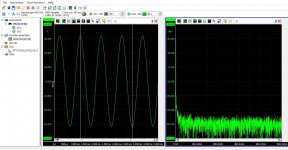Well its getting there!
Connected all the dots now and the XY just went pop and buzzzz. He he.
Reconnected the cut traces for signal ground and it was fine.
Will cut them again as soon as the amp is in a chassis with proper ground.
Guess a separate ground cable must go from the point of cut traces?
Anyway - it sounds great! Turned the volume to max whit no input signal - no noise. Got <0,6 mv dc on output.
Gonna compare it to the Juanjing gainclone when everything is in place.
If you are following my advice, you need to connect the grounding point of the 22 uF, now disconnected from the bottom ground plain, with a short piece of wire to the ground terminal of the loudspeaker output.
If you are following another recipe, good luck, it will make matters worse.
Did you cut the input ground trace like vacuphile suggested? The amp will only work if there are multiple boards with at least one board with the trace intact.
It may work to reduce hum caused by ground loops. The problems are bad input grounding (using other channels ground connections), chip inputs are not referenced to the same point (feedback&input) and floating chip ground pin when no is source connected.
It may work to reduce hum caused by ground loops. The problems are bad input grounding (using other channels ground connections), chip inputs are not referenced to the same point (feedback&input) and floating chip ground pin when no is source connected.
No, I cut the traces as did in this thread. The ones connecting signal ground to C4.
Bought a XY LM3886 Kit. - Page 38 - diyAudio
Bought a XY LM3886 Kit. - Page 38 - diyAudio
This thread is not about building/hacking XY boards/kits. We seem to have wandered off from Tom's original topic of measurements of the XY and potential effects of a 'fake' LM3886.
Good.We seem to have wandered off from Tom's original topic of measurements of the XY and potential effects of a 'fake' LM3886.
we learn nothing by testing "fakes" other than they can't be expected to perform as well as the genuine product.
A test report of the two PCBs offered by Tomchr and XY and both fitted with genuine parts would have done this Forum a great service.
We have been offered this some time in the near future.
But in the meantime there is nothing to be gained in further assessing fake components and how badly they perform.
Are the xy-board LM's fakes? Have we established this?
In First post, Tom: I have seen many, many National parts none of them were marked in ink. I did give XY the benefit of the doubt, though. It could be an old stock part...
See post 13:
http://www.diyaudio.com/forums/chip-amps/294032-xy-lm3886-kit-review-measurements-2.html#post4769879
First post continued: So I had a friend at TI look up the lot code "PM52AE". This lot code does not exist in the TI/National system. The "LM3886" that I received as part of the XY kit is fake. I am 99.999999 % certain of this ...
PDF form Ti:
http://www.ti.com/lit/an/snoa039c/snoa039c.pdf
PM52AE:
P= wafer plant, China (sub-con)
M= assembly plant, Malacca, Malaysia
52 Y/W = 2005 or 2015 / week 12-17
AE= The die run code is a two letter alpha code, ranging from AB through ZZ for each device
From the above, I conclude: There is no reason to assume XY LM's are fake...
In First post, Tom: I have seen many, many National parts none of them were marked in ink. I did give XY the benefit of the doubt, though. It could be an old stock part...
See post 13:
http://www.diyaudio.com/forums/chip-amps/294032-xy-lm3886-kit-review-measurements-2.html#post4769879
First post continued: So I had a friend at TI look up the lot code "PM52AE". This lot code does not exist in the TI/National system. The "LM3886" that I received as part of the XY kit is fake. I am 99.999999 % certain of this ...
PDF form Ti:
http://www.ti.com/lit/an/snoa039c/snoa039c.pdf
PM52AE:
P= wafer plant, China (sub-con)
M= assembly plant, Malacca, Malaysia
52 Y/W = 2005 or 2015 / week 12-17
AE= The die run code is a two letter alpha code, ranging from AB through ZZ for each device
From the above, I conclude: There is no reason to assume XY LM's are fake...
what about the other fake components?
We should be comparing PCBs and the expertise put into PCB layout design to get the chipamp to perform properly.
We should be comparing PCBs and the expertise put into PCB layout design to get the chipamp to perform properly.
Which fake components?
Let's assume that all components are genuine. What Tom has measured is, difference in PCB design and in value of components and adding proper networks for stability etc. That's maybe the expertise difference in the measurements of the two boards we like to know?
Let's assume that all components are genuine. What Tom has measured is, difference in PCB design and in value of components and adding proper networks for stability etc. That's maybe the expertise difference in the measurements of the two boards we like to know?
Last edited:
I don't agree that testing fakes has no value. For me it seems it is "good enough". And that has value. And if one of the other parts is causing the distortion, it is useful to know witch part to replace.
My use for this amp is in active multiway cheap speaker. Then 8 to 10 amps can be needed. (Only one powersupply for each speaker)
But for us EU related, it is illegal to knowingly import fake goods....
My use for this amp is in active multiway cheap speaker. Then 8 to 10 amps can be needed. (Only one powersupply for each speaker)
But for us EU related, it is illegal to knowingly import fake goods....
I agree. I have stated the same for many of our newer Members: "don't buy kits from far east vendors". The risk of buying fake components is too high.What Tom has showed us, is that DO NOT BUY THE XY-KIT FROM CHINA.
Buy only the PCBs...
I have recommended buying PCBs from those same vendors.
Less money at risk if the PCB turns out to be scrap. But this is unlikely unless you need to remove components where poor adhesion of the trace to substrate can become a problem.
What Tom has showed us, is that DO NOT BUY THE XY-KIT FROM CHINA.
Buy only the PCBs...
Funny, I would do the opposite, that's what I read between the lines of this thread... If you buy or have bought the kit, ditch the pcb and use the parts to make a p2p circuit. I think the pcb is the culprit here, not necessarily the components. Feedback trace pin3-9 is way too long. Cs On V+ V- not close enough to the chip supply pins. You can make the circuit in 3D, which has some advantages. Add Zobel/Thiele network. Make a good grounding scheme. Could be that this XY kit, without the pcb measures pretty good.
On a side note: What I am missing in many circuits is this: a signal consists of 2 wires, then I like to see where they go, many ground symbols in a circuit, confuses me.
I'd say, buy the XY kit. Ditch everything but the five metal film resistors. Use the metal film resistors for populating one of my LM3886DR boards. Or just order the components from Mouser and the board from me and get something that works well without the need for hacking.
Each to his own.
Tom
Each to his own.
Tom
Funny, I would do the opposite, that's what I read between the lines of this thread... If you buy or have bought the kit, ditch the pcb and use the parts to make a p2p circuit. I think the pcb is the culprit here, not necessarily the components. Feedback trace pin3-9 is way too long. Cs On V+ V- not close enough to the chip supply pins. You can make the circuit in 3D, which has some advantages. Add Zobel/Thiele network. Make a good grounding scheme. Could be that this XY kit, without the pcb measures pretty good.
Well...
As can be seen from Toms own measurements, the XY-amp (and PCB) is not a complete disaster. Look at performance between 1 and 2W for example.
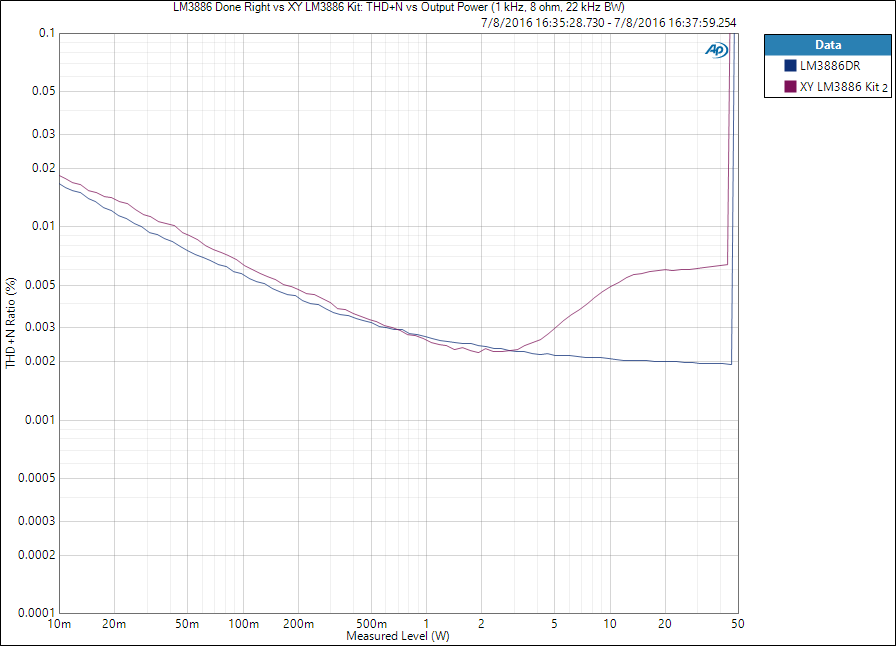
We can see, that the XY has higher noise than the DR. Notice that XY is missing noise filtering from input. Easiest thing to put a ceramic on the bottom side of the PCB if one must.
We can also see, that XY has poorer performance in full power. Notice that the chinese put the cheapest power capacitors in their kit, Tom has organic polymer. So change those.
It is missing the zobbel. Must be added to the bottom side again. For output R||L you already have a nice place on the board.
You will never get the same performance as Tom gets from his amplifier, but you can get pretty darn close, if you ask me.
But this is all off topic. This is not a PCB comparison, this is a random kit comparison.
Last edited:
Tom tested one kit of the many XY kits available. XY make the PCB and others compile the kits. Some kits may have fake/bad parts, others may not.
Tom has designed the DR to work well at high power and with difficult loads and when you only look/compare/test these things the XY will always come second.
I would like to see how they compare when used in a 4 channel amp with a non-regulated power supply. In particular ground loop problems. What you often see is that the measures taken by builders to combat hum are going to increase THD. But at this point you are just happy to have lost the hum.
Tom has designed the DR to work well at high power and with difficult loads and when you only look/compare/test these things the XY will always come second.
I would like to see how they compare when used in a 4 channel amp with a non-regulated power supply. In particular ground loop problems. What you often see is that the measures taken by builders to combat hum are going to increase THD. But at this point you are just happy to have lost the hum.
Last edited:
I have some of these LM3886TF chips with fat serifs and bogus lot codes. Have you ever tried using these in a modulus86? Since all we are really using the chip for is dumping current in that design I would be curious to see its measured result there.tomchr said:That's not to say that the copycats can't copy the lot code, but at least in case of the LM3886 I received from XY, they just made up one.
I have some of these LM3886TF chips with fat serifs and bogus lot codes. Have you ever tried using these in a modulus86? Since all we are really using the chip for is dumping current in that design I would be curious to see its measured result there.
I don't use fake parts. I simply don't see the point when I can buy the real ones for not that much money directly from the distributors (Mouser, Digikey, Newark, RS, Farnell, etc). By buying from the distributors, I know what I'm buying.
Who knows what's inside the fake LM3886es. If it's a different die or a die that has failed the gain-bandwidth product test, it will result in stability issues in a composite amp, such as the Modulus-86. I'm not going to risk my business on that.
Tom
Found my 10+ year LM3886T veroboard amp.
I might have a try of some measurements this weekend? Well see.
Still working. Noise with no load at under 1mV with TiePie scope.
I might have a try of some measurements this weekend? Well see.
Still working. Noise with no load at under 1mV with TiePie scope.
Attachments
Last edited:
I didn't suggest that you should on a flagship product like the Mod86 but for a person looking to possibly knock $60 off their mod 86 build, it might be a plausible option. I was waiting for a report from your TI contact on the "out of spec LM3886 chips" and never saw any further discussion about them. If you did address this, please link me. Out of spec chips often retain enough utility to be usable depending on which spec failed. I am of the strong opinion that these bogus lot marked chips are exactly that but I am eager to be corrected. Just for ***** and giggles, I can send you the parts from a Yuanjing kit along with the THAT drivers. I'll buy the boards after you test them no matter what happens. PM me if this interests you. Oh, one more thing; I've read you like the Panasonic supply caps, do you have an opinion of the Rubycon 50V 105C MXR series?tomchr said:I don't use fake parts.
- Home
- Amplifiers
- Chip Amps
- XY LM3886 Kit Review & Measurements
